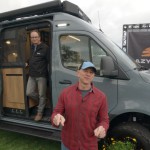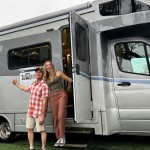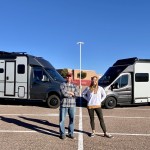This post may contain affiliate links.
We were recently invited to come out to Silicon Valley to have a look at an interesting travel trailer that’s currently in development, the Pebble Flow. We got to see the Flow in the lab at Pebble, and we did as much of a full review as we could on in in-development RV. The result is this video. Have a look!
Pebble has pretty ambitious goals for some of the features they’re working on. I can’t predict the future, but even if only half of these features hit, the Flow would still be a unique & innovative travel trailer well above today’s industry standard.
The video is long, because I included our discussion with the CEO and CTO at the end. So if you’re interested and have questions, I encourage you to stick around through that discussion. You likely have some of the same questions we did.
But for those of you who want a Cliff’s Notes version of the things I found interesting in the Pebble Flow, here you go.
The Battery Bank:
The Pebble Flow has a proper EV battery. That’s 45kWh at 400 volts. The capacity of that battery is more than twice what we currently have in our own RV – and we never want for battery power.
Self-Propulsion / Regenerative Charging:
The Flow will be capable of assisting in its own propulsion, so you could potentially tow it with an EV and not see much of a hit on your range. (Imagine towing a vehicle with zero weight.) On the other hand, if you’re towing it with a traditional gasoline or diesel vehicle, the Flow will have the ability to take energy out of its spinning wheels and charge its battery. (Presumably, this would result in additional load on the tow vehicle – nothing comes for free…) I asked a bit more about this, and this behavior will be user-controllable through their app. So depending on what your power situation is at your destination, you can adjust the charging to suit.
Stable Towing:
Since the wheels on the Pebble Flow will be capable of producing torque while you drive, it should be able to assist in its stability while underway. Think crosswind assist. Think stability assist. Many of the towing accessories people are used to may no longer be necessary. It’s a non-trivial engineering problem, but there are a lot of intriguing possibilities here.
HVAC:
It was still in development while we were there, so I don’t have any specifications to share, but think about climate control in the Pebble Flow as being based on mini-split heat pump technology. It should be efficient. It should be quiet. I know many RVers are interested in swapping out their HVAC for a mini-split, but those solutions usually wind up looking like the Clampett’s truck from The Beverly Hillbillies. What we saw in the Pebble Flow looked much more refined than any RV mini-split installation I’ve ever seen. I will be curious at what temperature “supplemental heat” kicks in, and what that does to battery life, but those kinds of tests are down the road a bit.
Remote Control Vehicle:
I got to use some trailer movers one time over in Germany. It was a hoot to drive a disconnected TT around a parking lot. Well, since the Pebble Flow will have powered wheels, that capability is going to be built in – not an aftermarket add-on. This should make it much easier to navigate the TT into tight campground parking spaces. The downside of this, of course, is that we’ll miss out on some of the entertainment of watching others trying to back up their travel trailer. HA!
The Windows:
There were no blinds in the Flow. But using the “magic glass” is about the most fun you’ll ever have opening or closing a window. (I played with it for way too long.) I’m not sure how much – if any – thermal insulation that glass provides. Before the Pebble Flow makes it to market, I wouldn’t be surprised if some thermal component was added to the windows to help with heat buildup in the summer. That’s just a guess.
Attention to Aero:
As a former Aerospace Engineer, this made me happy to see. Normal travel trailers are shaped like… well like bricks, honestly. A normal travel trailer will tow like garbage and suck your mileage because there’s absolutely no attention to aerodynamics in the design.
The Pebble Flow is different. They paid a LOT of attention to aerodynamics when designing the exterior of the vehicle. The motorized shroud on the tongue is just fantastic – optimizing airflow when it’s towed, and out of the way when it’s not. I couldn’t show you underneath, but they also have skirting under the RV covering up most of the gaps to improve airflow even more. Even without the active propulsion, the Pebble flow should tow better than just about any other travel trailer out there.
There’s a lot more to the Pebble Flow, and if you’re interested – or even if you’re just interested in watching a team push the boundaries of the travel trailer – I encourage you to watch the whole video.
Cheers!











Were you able to get a sense of how well it blocks sound? If it was closed up, would you be able to hear people outside having a normal conversation?
We only got to be inside it while it was in their shop facility, so we really can’t answer that. Sorry!
I am late to the Pebble game. I recently saw it at the RV Show in Pleasanton and I found your walkthrough as part of my search.
The Pebble iPhone integration is an extension of our interaction we had on FB where you pointed me to Winnebago Connect.
I am hopeful to see more smart phone integration to make RVs easier to use and troubleshoot.
Anyway, I had an interesting discussion with the folks hosting the show. I get the feeling that Pebble is trying to be the “Tesla” of the RV world. And as such, I asked one of their marketing folks what percentage of their market were Tesla owners. They declined to state.
I wish the company luck. But ultimately, I think they are going to have challenges overcoming two large obstacles.
First is the target audience isn’t interested in road trips. Ask Tesla owners how far they take their vehicles away from home base. Great commute vehicle. Not so great for extended road trips to Moab (away from a charging infrastructure).
Second obstacle is the energy density of batteries compared to fossil fuels. My 144” Sprinter has a 45g tank and Rixen/Espar heater. I will die from lack of water before I run out of heat.
Even with a heat pump, how long will Pebble battery keep unit warm without hookups? 2-3 days?
And great point about servicing. I suspect Pebble will primarily sell to upscale buyers in Silicon Valley. So probably won’t need nationwide dealer network.
I agree with most of your points.
Interesting you should mention Moab.
There’s actually a good sized bank of Tesla chargers in Moab. Has been for years!
I am new to the EV thing so pardon me if this question is stupid. As a CYA, would I be able to charge the camper with says a Honda 2000 quiet run? As others have said, ac and heating use a ton of energy, even the most energy conservative models. Though that is a large battery bank, it could easily drain that system down overnight. The concept of being out in nature without thengenerator sound in the background is pure bloss but dying of frostbite kinda overwhelms the positive of silence lol
The short answer is, yes, it should be possible.
The longer answer is: be prepared for it to take a looong time.
The Pebble Flow has a 45kWH battery bank. The best-case output of the Honda 200 is 2kW. So simple napkin math says it would take the Honda 22.5 hours to fully charge the battery bank. There would also likely be some losses in converting the 120v AC output into the 400v DC that’s native to the batteries. So to reiterate, possible, but might take quite a while.
That said, if you started a Honda 2000, it’s entirely feasible that it would be able to “keep up” with demand, so you might be able to keep the battery from excessively discharging.
So about service and EVs: the real answer is, it’s a pain. We have a Tesla. Yes, they can send out a service tech, but only for little stuff. If you have a big issue, you need to have the vehicle towed to one of their service centers. We live 3 hours from the nearest. We’re ready to get rid of our Tesla and get something that can be serviced locally as a result.
If Rivian added a service center in our region, I’d get one. But more likely in the near term, I’m contemplating a plugin hybrid as more practical, sadly.
The charge port you showed is CCS1, which can be used at DC fast chargers, though the industry is moving to NACS (the Tesla connector), so expect Pebble to do that too. The CCS1 connector is an extension of the J1772 (the upper part, that’s used for 120/240v charging).
We don’t have an EV ourselves, so interesting to hear the service story from someone living it!
1) I didn’t see anything about window screens, which would appear to be a necessity. 2) While phase change windows are cool, they are expensive to include and more expensive to replace. 3) Being able to move the trailer with it’s own motor may be the best feature. However, if the electrical system goes out, ALL power assisted driving is out too. 4) While they say it’s not needed, something that size should probably have a good stabilizing sway bar hitch coupled with a truck with a solid Class 4 hitch. 5) This much electric would be great for extended boondocking but question if it’s rugged enough to handle unimproved roads. 6) I expect this is all electric, no propane. I have yet to see an all electric heating system that didn’t consume wattage at an alarming rate.
Correct, no propane. And these are all excellent points! It’ll be interesting to see how Pebble addresses them.
Could you provide more detail on grey/black tank dumping? Will it require a traditional dump station vs some kind of removable, transportable cassette that can be dumped at any toilet?
We don’t have any more details at this time.
However, we were led to believe it would be more along the lines of a traditional RV dump – not something like a cassette toilet.
Also not realistic to not have propane or some other power option these days.
Really nice, except why does everything always have to be white would be beautiful in a black seating option.
I applaud the aero aspects and design in general, but unless I missed it what is the material and construction of the trailer? Does it have an internal frame? What about insulation?
The black panels “look nice and sleek” especially when new, but in the real world of using a RV you are exposed to rocks, dirt and mud. I’m curious how this will look after a few months.
Good questions.
As for the construction, I believe it’s a two layer shell with insulation between. Don’t know about any internal framing. The only ones we saw were already assembled. No in-process units on the day we were there.
And yes, black might show wear more than some other color choices would, for sure.
I didn’t see weight distribution addressed. That would be important. But I love the idea of this trailer. And why didn’t you leave a link to their website?
Didn’t get any info on weight distribution or tongue weight. Good questions though.
And I thought I put a link to their website in the first paragraph of this post. Didn’t I?
I’ll go check and if there’s not one there, I’ll add it.
Very neat. I do wish the website wasn’t quite so… modern… as it makes information a bit hard to find. For those curious, the two basics:
GVWR: 6200 lbs. (no mention of est. tongue weight)
Price: $109K for the base model; $125K for the motorized wheel version.
Thanks for posting the details!
At that price it’s less than the most comparable Airstream (Tradewind), which isn’t anywhere near as well equipped or modern in design. It only has 9.7kwh of battery and 600w of solar, not to mention no self driving or auto hitch. Wish Pebble would add propane for a duel heating system like the Truma Combi and outdoor cooking.
They’re pretty firm on the “all electric” thing. I don’t have any performance data on their heat pump/mini-split HVAC. Hopefully it can keep up with aux. heat when the temperatures get really cold.
You’re right about the price point though – it’s pretty attractive for a trailer with all those features.
Hello! Just watched the Pebble Flow video. Veddy interesting.
So. Maybe James has already done this, but I would love to watch a vid of James inventing his perfect rv/camper/trailer whatevs. (With diagrams and graphics of course) Maybe he has the time and inclination?
I’m sure it would include magic windows.
Love you guys
Charla Garth
If it did include magic windows, they would be *double pane* magic windows… 😉